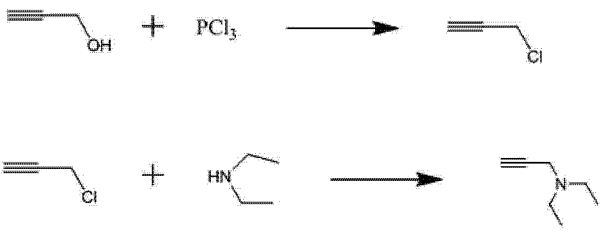| Identification | More | [Name]
1-Diethylamino-2-propyne | [CAS]
4079-68-9 | [Synonyms]
1-(DIETHYLAMINO)-2-PROPYNE
3-DIETHYLAMINO-1-PROPYNE
n,n-diethyl-2-propynylamine
N,N-DIETHYLPROPARGYLAMINE
TIMTEC-BB SBB008754
1-Diethylaminopropyne-2
1-N,N-Diethylamino-2-propyne
2-Propyn-1-amine, N,N-diethyl-
2-Propynylamine, N,N-diethyl-
3-(Diethylamino)propyne
3-(N,N-Diethylamino)propyne
diethylpropargylamine
n,n-diethyl-2-propyn-1-amin
N,N-Diethyl-2-propyn-1-amine
n,n-diethyl-2-propynylamin
3-DIETHYLAMINO-1-PROPYNE, FOR SEQUENCEAN ALYSIS
3-DIETHYLAMINO-1-PROPYNE 98+%
DEP
3-DIETHYLAMINO-1-PROPENE
Diethylamino1prop2yne | [EINECS(EC#)]
223-804-5 | [Molecular Formula]
C7H13N | [MDL Number]
MFCD00039881 | [Molecular Weight]
111.18 | [MOL File]
4079-68-9.mol |
| Safety Data | Back Directory | [Hazard Codes ]
F,Xn,C | [Risk Statements ]
R11:Highly Flammable.
R21/22:Harmful in contact with skin and if swallowed .
R34:Causes burns. | [Safety Statements ]
S26:In case of contact with eyes, rinse immediately with plenty of water and seek medical advice .
S36/37/39:Wear suitable protective clothing, gloves and eye/face protection .
S45:In case of accident or if you feel unwell, seek medical advice immediately (show label where possible) . | [RIDADR ]
UN 2733 3/PG 2
| [WGK Germany ]
3
| [RTECS ]
UK5775000
| [F ]
8-10-13-23 | [TSCA ]
Yes | [HazardClass ]
3 | [PackingGroup ]
I | [HS Code ]
29211990 |
| Hazard Information | Back Directory | [Description]
N,N-Diethylpropargylamine is a kind of nickel plating brightener with excellent performance and excellent levelling effect. It is widely used in nickel plating and alloy plating industry, because it is insoluble in water, it is generally used after reacting with acid to form quaternary ammonium salt before use, meanwhile, it is also a kind of pharmaceutical intermediates and pesticide intermediates, and has certain application fields in fine chemical industry. | [Uses]
3-Diethylamino-1-propyne is used as functional leveling agent, brightener. | [Synthesis Reference(s)]
Journal of the American Chemical Society, 81, p. 693, 1959 DOI: 10.1021/ja01512a047 | [Flammability and Explosibility]
Flammable | [Synthesis]
According to the processing condition difference reported at present, two kinds of synthesis techniques, respectively atmospheric low-temperature alkalization method and high-pressure catalysis method. The atmospheric low-temperature alkalization method generally is divided into two steps: 1) propionic alcohol reacts with phosphorus trichloride and generates propine chlorine under cold conditions; 2) upper step gained propine chlorine is reacted with diethylamine under the low-temperature alkali condition and generate N, N-diethyl propargylamine. As shown in the reaction formula:

|
|
|